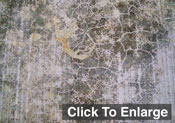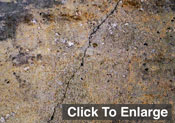Typical Surface Damage:
 Crazing cracks"
are fine, random cracks that penetrate the laitance and sometimes penetrate the actual concrete structure. They allow
water and chemicals to enter the concrete and cause early deterioration of the surface. Crazing cracks"
are fine, random cracks that penetrate the laitance and sometimes penetrate the actual concrete structure. They allow
water and chemicals to enter the concrete and cause early deterioration of the surface.
 Spalling typically
starts when small fragments of the exposed laitance surface detach and create a rough surface. The damage is caused by the
action of weather such as freeze-thaw, wet-dry cycling, and pressure created by expansion within the concrete. Spalling typically
starts when small fragments of the exposed laitance surface detach and create a rough surface. The damage is caused by the
action of weather such as freeze-thaw, wet-dry cycling, and pressure created by expansion within the concrete.
 Spalling
will continue to grow deeper and wider unless corrected, the surface becomes unsafe for walking and vehicular traffic. Spalling
will continue to grow deeper and wider unless corrected, the surface becomes unsafe for walking and vehicular traffic.
 Scaling and
"popouts" are other common forms of concrete surface deterioration. It begins by moisture penetrating the laitance surface. Scaling and
"popouts" are other common forms of concrete surface deterioration. It begins by moisture penetrating the laitance surface.
Why Coat Your Garage Floor?
Concrete is one of the most common building materials in the world. It is a man made product containing cement, sand, gravel and water, but the simplicity ends there.
Whether it be slabs, blocks, walls, roofs, piers, beams, pipe, etc., concrete is extremely vulnerable to the industrial society of today. Sulfuric acid is the most damaging to concrete. Automobiles exhaust spread sulfuric acid when mixed with water. These products are constantly being spilled in our concrete and absorbed by it through its pores.
When placed, concrete begins the hydration process (transition from a fluid state to a solid one). The water begins to evaporate leaving behind millions of little holes known as pores. If you look at concrete under a microscope it would look like a natural sponge. Often the pores create hairline cracks inside the concrete.
If not sealed, concrete pores are exposed to a chain reaction of absorption of water from rainfall, and moisture in the air. As this migration is taking place, many other destructive pollutants are also being absorbed into the concrete (sulfate, salts, lime, random odors and all kinds of contaminates), and some of them are held captive in the pores of your concrete, creating rapid decay.
Another point: algae, mildew and moss are present on concrete because of the moisture in it. Moisture is the cause these plants and bacteria survive. If the moisture is eliminated by sealing the concrete, you have eliminated a place for these pollutants to exist.
On the other end is the alkali problem. Alkali is made up of a combination of elements including hydrogen, lithium, sodium, potassium, rubidium, cesium and francium, all chemical elements, which are present in the earth's crust. Because alkali is soluble in water, once the concrete gets wet this becomes a destructive solution.
|

